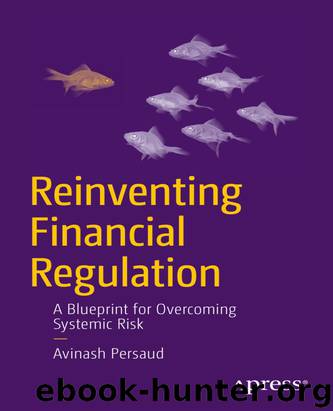Reinventing Financial Regulation: A Blueprint for Overcoming Systemic Risk by Avinash Persaud

Author:Avinash Persaud [Persaud, Avinash]
Language: eng
Format: epub
Publisher: Apress
Published: 0101-01-01T00:00:00+00:00
___________________
1This chapter is the development of my article, “Regulation, Valuation And Systemic Liquidity,” Banque de France, Financial Stability Review, no. 12, October 2008.
2The stated intent of IAS 39, or the International Accounting Standard 39, is to harmonize accounting standards internationally. These standards are set by the International Accounting Standards Board, which is an independent body of the IFRS Foundation that is monitored by, and accountable to, the European Commission, the Japanese Financial Services Agency, the US Securities and Exchange Commission, the Emerging Markets Committee of IOSCO, and the Technical Committee of IOSCO—the International Organization of Securities Commissions. IOSCO is comprised of 120 securities regulators and 80 securities market participants. These accounting and reporting standards are the standard used in the EU and many other countries except the United States, which uses its own set of rules known as GAAP, or Generally Accepted Accounting Principles.
3I recall a discussion about a survey of buyers of credit derivative instruments that happened just before a meeting of CESR, the Committee of European Securities Regulators, at which I gave a presentation. If memory serves, the meeting took place in Paris sometime in 2008. Almost every respondent reported that credit derivative instruments were now extremely cheap but they would not be buying any. Through their risk management systems formidably high capital requirements were imposed for holding instruments with high volatility whether they were near rock bottom or not.
4See in particular Chapters 3, 5 and 6.
5One with a similar risk of credit default or that is similarly exposed to the volatility of some market price. An example is the shares of two oil companies with similar exposures but where one has a larger free float of shares.
6Under Basel II, banks that could boast sophisticated price-sensitive risk models like Value-at-Risk (VaR) and Daily Eearnings At Risk (DEAR) could adopt the internal risk model approach to calculating capital adequacy, often resulting in lower capital adequacy requirements.
7I suspect I was called a heretic more often than some who now try to argue they called it right, but in godless Britain being called a heretic is often a compliment. I recall in 2005 one official from the UK’s FSA, who has gone on to very senior regulatory positions, responded to my suggestion that risk transfers should not be left entirely to the market but incentivised to go where they are best absorbed, by calling me a “Stalinist”. Now that hurt.
8This sometimes happened within the same institution. Early on in the crisis, Charles Goodhart observed that many of the banks that needed to be rescued or failed in the GFC were those that appeared to follow the “originate and relocate” model, where loans were issued and then packaged into groups of loans that were then securitized and sold off, but they did not relocate the risks far enough. Holding the opinion that these instruments were of good value, they clung on to too much of the risk in off-balance-sheet special-purpose vehicles to which they also foolishly extended a liquidity backstop. For a detailed study of this behavior, see Viral V.
Download
This site does not store any files on its server. We only index and link to content provided by other sites. Please contact the content providers to delete copyright contents if any and email us, we'll remove relevant links or contents immediately.
The Meaning of the Library by unknow(2385)
Six Billion Shoppers by Porter Erisman(2226)
Why Nations Fail: The Origins of Power, Prosperity, and Poverty by Daron Acemoglu & James Robinson(2172)
No Time to Say Goodbye(1997)
Red Notice by Bill Browder(1924)
The Economist [T6, 22 Thg9 2017] by The Economist(1843)
Currency Trading For Dummies by Brian Dolan(1788)
Thank You for Being Late by Thomas L. Friedman(1679)
Bitcoin: The Ultimate Guide to the World of Bitcoin, Bitcoin Mining, Bitcoin Investing, Blockchain Technology, Cryptocurrency (2nd Edition) by Ikuya Takashima(1613)
Amazon FBA: Amazon FBA Blackbook: Everything You Need To Know to Start Your Amazon Business Empire (Amazon Empire, FBA Mastery) by John Fisher(1496)
Coffee: From Bean to Barista by Robert W. Thurston(1419)
The Future Is Asian by Parag Khanna(1401)
The Great Economists by Linda Yueh(1389)
Capitalism Without Capital: The Rise of the Intangible Economy by Jonathan Haskel(1339)
Pocket World in Figures 2018 by The Economist(1327)
How Money Got Free: Bitcoin and the Fight for the Future of Finance by Brian Patrick Eha(1322)
Grave New World by Stephen D. King(1315)
The Sex Business by Economist(1279)
Cultural Intelligence by David C. Thomas(1201)
